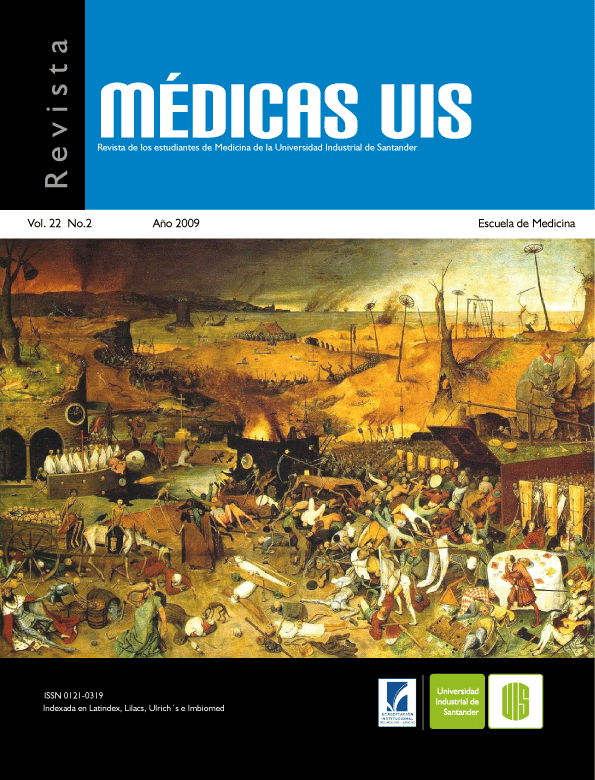Abstract
The objective of this article is a review of cardiogenic shock, including its pathophysiology, symptoms and signs, and current treatment. The study was done through the analysis of randomized and multicentric studies. Diverse articles about cardiogenic shock were also used. Cardiovascular diseases are the major cause of death in the world. Of these deaths, the majority are due to heart attacks and stroke. Cardiogenic shock is the most critical expression of coronary artery disease because is high morbidity and mortality. Cardiogenic shock continúes to complícate less than 10% of myocardial infarction but his mortality could be more than 80% when the treatment is inappropriate. Systolic and diastolic ventricular dysfunctions are the pathophysiologic of cardiogenic shock and the cause is the acute aggravation of coronary artery disease by insuffcient irrigation on the myocardial tissue (total or partial occlusion) as well by systemic infammatory response syndrome. The leading clinical symptoms are hypotension and hypoperfusion (oliguria, cyanosis, change in mental status, cold extremities) and the hemodynamic changes are just additional information to support the diagnosis and to defne the optimal treatment. The treatment also includes correction of hypoxia, acidosis and hydroelectrolytics disturbances. Adjunct pharmacologic therapy usually based on catecholamines and phosphodiesterase inhibitors are useful in the treatment but the survival is modifed only by early revascularization (interventional or surgical). Implantation of an intraortic balloon pump is justifed. Temporary mechanical circulatory support with left ventricular assist devices is indicated as a bridge to heart transplantation. The successful treatment result by prompt recognizes patients in risk and an invasive approach with early revascularization. The goal of any therapy in cardiogenic shock is to restore nutritional blood fow and prevent further damage of vital organs.
Key words: Acute myocardial infarction. Cardiogenic shock. Coronary disease percutaneous coronary intervention.
References
2. Hochman JS, Sleeper LA, Webb JG, Sanborn TA, White HD, Talley JD, et al. Early revascularization in acute myocardial infarction complicated by cardiogenic shock. N Engl J Med 1999;341:625-34.
3. Goldberg RJ, Samad NA, Yarzebski J, Gurwitz J, Bigelow C, Gore J. Temporal trends in cardiogenic shock complicating acute myocardial infarction. N Engl J Med 1999;340:1162-8.
4. Webb JG, Sleeper LA, Buller CE, Boland J, Palazzo A, Buller E, et al. Implications of the timing of onset of cardiogenic shock after acute myocardial infarction: a report from the SHOCK Trial Registry. J Am Coll Cardiol 2000 (suppl A); 36:1084-90.
5. Hochman JS. Cardiogenic Shock Complicating Acute Myocardial Infarction: Expanding the Paradigm. Circulation 2003;107:2998-3002
6. Nieminen MS, Bo ̈hm M, Cowie MR, Drexler H, Filippatos GS, Jondeau G, et al. Guidelines for the diagnosis and treatment of acute heart failure European Society of Cardiology. European Heart Journal 2005;26:384–416.
7. Killip T, Kimball JT. Treatment of myocardial infarction in a coronary unit. A two year experience with 250 patients. Am J Cardiol 1967;20:457-64.
8. Ducas J, Grech ED. Percutaneous coronary intervention: cardiogenic shock. BMJ 2003;326:1450-2.
9. Adams HA, Baumann G, Gansslen A. Definition of shock types. Anaesthesiol Intensivmed Notfallmed Schmerzther 2001 (suppl 2);36:S140-S3.
10. Reynolds HR, Hochman JS. Cardiogenic Shock. Current concepts and improving outcomes. Circulation 2008;117:686-97.
11. Tsukahara Y, Morisaki T, Horita Y. Expression of inducible nitric oxide synthase in circulating neutrophils of the systemic inflammatory response syndrome and septic patients. World J Surg 1998;22:771-7.
12. Drexler H. Nitric oxide synthase in the failing heart: A doubleedged sword? Circulation 1999;99:2972-5.
13. Wink DA, Hanbauer I, Krishna MC. Nitric oxide protects against cellular damage and cytotoxicity from reactive oxygen species. Proc Natl Acad Sci USA 1993;90:9813-7.
14. Heymes C, Vanderheylen M, Bronzwaer JG. Endomyocardial nitric oxide synthase and left ventricular preload reserve in dilated cardiomyopathy. Circulation 1999;99:3009-16.
15. Flesch M, Kilter H, Cremers B. Acute effects of nitric oxide and cyclic GMP on human myocardial contractility. J Pharmacol Exp Ther 1997;28:1340-9.
16. Cotter G, Kaluski E, Blatt A. L-NMMA (a nitric oxide synthase inhibitor) is effective in the treatment of cardiogenic shock. Circulation 2000;101:1358-61.
17. Depré C, Vanoverschelde JL, Goudemant JF. Protection against ischemic injury by nonvasoactive concentrations of nitric oxide synthase inhibitors in the perfused rabbit heart. Circulation 1995;92:1911-8.
18. Schulz R, Wambolt R. Inhibition of nitric oxide synthesis protects the isolated working rabbit heart from ischemia-reperfusion injury. Cardiovasc Res 1995;30:432-9.
19. Brunner F, Andrew P, Woelkart G. Myocardial contractile function and heart rate in mice with myocyte-specific overexpression of endothelial nitric oxide synthase. Circulation 2001;104:3097-102.
20. Alonso DR, Scheidt S, Post M. Pathophysiology of cardiogenic shock: Quantification of myocardial necrosis, clinical, pathologic and electrocardiographic correlations. Circulation 1973;48:588-96.
21. Hochman JS, Buller CE, Sleeper LA, Boland J, Dzavik V, Sanborn TA, et al. Cardiogenic shock complicating acute myocardial infarction—Etiologies, management and outcome: A report from the SHOCK trial registry. Should we emergently revascularize occluded coronaries for cardiogenic shock? J Am Coll Cardiol 2000 (suppl A); 36:1063-70.
22. Dell’Italia LJ, Starling MR, O’Rourke RA. Physical examination for exclusion of hemodynamically important right ventricular infarction. Ann Intern Med 1983;99:608-11.
23. Dell’Italia LJ, Starling MR, Crawford MH, Boros BL, Chaudhuri TK, O’Rourke RA. Right ventricular infarction: identification by hemodynamic measurements before and after volume loading and correlation with noninvasive techniques. J Am Coll Cardiol 1984;4:931-9.
